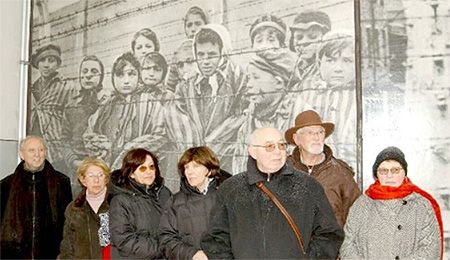Finding the Children Behind the Barbed Wire
When commemorating historical events of the past, we often turn to archival photographs for a glimpse of what these events looked like. At USC Shoah Foundation, one particular photograph has always caught our eye: the image of a group of children standing behind the barbed wire fence of Auschwitz, just after the camp’s liberation. Two close friends of the Institute are in the photograph – Paula Lebovics and Eva Slonim, both of whom gave testimony to the Visual History Archive and have long identified themselves as two of the girls in this now-famous photograph.
But this got us wondering: What about the rest of the children? Who are they and what are their stories? This summer, we set off on a seven-month-long mission to find out.
First, we found multiple versions of the photo. Each was taken from a slightly different angle and revealed and obscured different children. This is because, we discovered, the photos were not really photos at all, but frames from a film taken by Captain Alexander Vorontsov, a Red Army cameraman from the Soviet film crew, who was attached to the 1st Ukrainian Front. He made this film immediately after Auschwitz was liberated.
Though we do not know on what date the films were recorded, we know that the film crew was at Auschwitz from January 27 to February 28, 1945. Eighteen minutes of the footage that was shot during that time was shown during the Nuremberg trials as proof of Nazi crimes. But other than that, the footage sat in Soviet archives until 1985 when a pair of West German documentary filmmakers, Irmgard and Bengt von zur Muhlen, produced “Liberation of Auschwitz 1945.” Interspersed throughout the documentary is an interview with Vorontsov. At the time he was the last living photographer of the six who photographed the liberation.
Our attention then turned to identifying all of the children. We found one list on several websites, but it didn’t have the correct number of boys and girls, or the correct total children, for that matter. But in August, we found the photo below, taken at the 60th anniversary of the liberation of Auschwitz, which confirmed the identities of six survivors living in Israel. With the help of Shoshana Mandel, a former interviewer for USC Shoah Foundation, we were able to find current contact information for Tomy Shacham, Erika Dohan, Bracha Katz, and the families of Gabriel Neumann and Shmuel Shelach.

Anne Marie Stein, USC Shoah Foundation communications director, and Inna Gogina, coordinator of international programs, identified Marta Wise, who is Eva Slonim’s sister, and confirmed Eva Mozes Kor and her twin sister Mirian Mozes Zeiger. Now, the only children that remained unknown were the second and fourth girls from the left and the boy in the back who is only visible by his cap in some angles.
In October, Stein came across an old Facebook post by Adrienne Ziegler-Shulman, who wrote that her mother was the second from left. Stein was able to get in touch with her and confirm that her mother Miriam Friedman Ziegler was indeed in the photo. Another Internet search found an interview with a woman named Ruth Webber who said she was the fourth from left (the “second tallest girl in the back row”). We were able to get in touch with her through her husband Mark, who had given testimony to USC Shoah Foundation nearly 20 years ago.
Finally, after a press release from the Institute stated that there would be a reunion of children from the photo at the 70th anniversary of the liberation of Auschwitz on January 27, Stein received an email from Mathias Hirsch in Switzerland, who confirmed that his father Gábor was the boy in the back of the photo.
Ultimately, Gábor Hirsch, Eva Kor, Miriam Ziegler and Paula Lebovics were able to attend the commemoration and pose for a new photo.